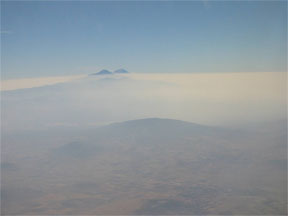Pollution in the stratosphere is clearly visible in this image in the thin red line.
Courtesy of NASA
Pollution from Asia Circles Globe at Stratospheric Heights
Air pollution can get high in the atmosphere – high above most of the clouds you see in the sky.
Scientists are finding air pollution more than 20 miles above the surface of the Earth. That’s in the stratosphere layer of the atmosphere. Once the air pollution is in the stratosphere, it spreads out and travels around the Earth. It can stay up there for several years.
Where is this pollution coming from? Scientists say the source is south Asia. That’s a place with lots of air pollution. Some of the pollution is from smokestacks at factories and power plants. Other pollution comes from burning trees and other plants to clear land.
The scientists have found that in this area of the world, air moves upward during summertime stormy weather. They have been studying measurements taken from satellites and found a pattern of more pollution in the stratosphere each summer for the past several years. In the future there might be even more pollution because the number of factories and power plants that release pollution in China and other Asian countries is growing.
How does this pollution high in the sky affect the planet? More research is needed to answer that question. But we do know that some types of pollution can cause small particles called aerosols to form in the stratosphere. Aerosols affect the ozone layer and climate.
Last modified May 21, 2010 by Lisa Gardiner.
You might also be interested in:

Have you ever heard of air pollution? Air pollution is not new. 700 years ago, when people started burning large amounts of coal 700 years ago in London, England, they complained about the dust and soot
...more
When you look up at the sky, you are looking at more than just air. There are also billions of tiny bits of solid and liquid floating in the air. These tiny particles are called aerosols or particulates.
...more
Most of the ozone that we know about is found in the the stratosphere, the second layer of the Earth's atmosphere. Ozone forms a kind of layer in the stratosphere. This layer shields us from the Sun's
...more
Scientists have learned that Mount Hood, Oregon's tallest mountain, has erupted in the past due to the mixing of two different types of magma. Adam Kent, a geologist at Oregon State University, says this
...more
The Earth's mantle is a rocky, solid shell that is between the Earth's crust and the outer core. The mantle is made up of many different reservoirs that have different chemical compositions. Scientists
...more
Some faults look strong and like they wouldn’t cause an earthquake. But it turns out that they can slip and slide like weak faults causing earthquakes. Scientists have been looking at one of these faults
...more
The sun goes through cycles that last approximately 11 years. These solar cycle include phases with more magnetic activity, sunspots, and solar flares. They also include phases with less activity. The
...more















